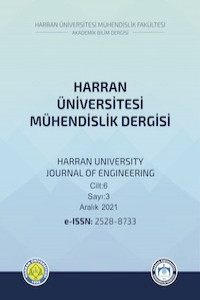Öz
Bu çalışmada, CCII kullanılarak akım modlu, kesirli dereceli, ikinci dereceden evrensel bir süzgeç tasarlanmıştır. Tasarlanan süzgeç için üç adet CCII (current conveyor, AD844A entegresi kullanılarak), üç direnç ve bir ucu topraklanmış iki adet kondansatör kullanılmıştır. Kesirli dereceli süzgeç tasarımı amacıyla geleneksel süzgeç yerine kesirli dereceyi sağlayacak paralel direnç ve kondansatörlerin seri bağlandığı Foster-I devre yapısı kullanılmıştır. Geleneksel kondansatördeki 1/sC empedans değeri, modelde 1/ s^αC değerine eşit olmaktadır (0 ≤ α ≤ 1). Bu çalışmada α =0.1, α =0.2, α =0.3, α=0.4, α=0.5, α =0.6,α =0.7, α =0.8, α =0.9 değerleri için model parametreleri hesaplanmış; (1+ α) değerine bağlı olarak derecesi 1.1, 1.2 , 1.3, 1.4, 1.5, 1.6, 1.7, 1.8, 1.9 olan süzgeçler ikinci derece süzgeç ile karşılaştırılarak kesirli dereceli süzgeçlerin avantajları ortaya konmuştur. Önerilen devrenin performansı ve teorik analiz sonuçları PSPICE benzetimi ile doğrulanmıştır.
Anahtar Kelimeler
Evrensel Süzgeç, Akım Modlu Devreler, Kesirli Dereceli Süzgeçler Akım Taşıyıcı
Kaynakça
- [1] Wang, H. Y., & Lee, C. T. (2001). Versatile insensitive current-mode universal biquad implementation using current conveyors. IEEE Transactions on Circuits and Systems II: Analog and Digital Signal Processing, 48(4), 409-413.
- [2] Kircay, A. (2014). Electronically tunable current-mode square-root-domain first-order multifunction filter. International Journal of Electronics, 101(2), 212-219.
- [3] Horng, J. W. (2001). High-input impedance voltage-mode universal biquadratic filter using three plus-type CCIIs. IEEE Transactions on Circuits and Systems II: Analog and Digital Signal Processing, 48(10), 996-997.
- [4] Radwan, A. G., Soliman, A. M., & Elwakil, A. S. (2008). First-order filters generalized to the fractional domain. Journal of Circuits, Systems, and Computers, 17(01), 55-66.
- [5] Kubanek, D., & Freeborn, T. (2018). (1+ α) fractional-order transfer functions to approximate low-pass magnitude responses with arbitrary quality factor. AEU-International Journal of Electronics and Communications, 83, 570-578.
- [6] Tripathy, M. C., Mondal, D., Biswas, K., & Sen, S. (2015). Experimental studies on realization of fractional inductors and fractional‐order bandpass filters. International journal of circuit theory and applications, 43(9), 1183-1196.
- [7] Radwan, A. G., Elwakil, A. S., & Soliman, A. M. (2008). Fractional-order sinusoidal oscillators: design procedure and practical examples. IEEE Transactions on Circuits and Systems I: Regular Papers, 55(7), 2051-2063.
- [8] P. Fanghella, Fractional-order control of a micrometric linear axis. J. Control Sci. Eng. (2013)
- [9] H. Li, Y. Luo, Y. Chen, A fractional order proportional and derivative (FOPD) motion controller: tuning rule and experiments. IEEE Trans. Control Syst. Technol. 18(2), 516–520 (2010)
- [10] Ma, C., & Hori, Y. (2007). Fractional-order control: Theory and applications in motion control [past and present]. IEEE Industrial Electronics Magazine, 1(4), 6-16.
- [11] Matušů, R. (2011). Application of fractional order calculus to control theory. International journal of mathematical models and methods in applied sciences, 5(7), 1162-1169.
- [12] AbdelAty, A. M., Radwan, A. G., Elwakil, A. S., & Psychalinos, C. (2018). Transient and steady-state response of a fractional-order dynamic PV model under different loads. Journal of Circuits, Systems and Computers, 27(02), 1850023.
- [13] Sahin, E., Ayas, M. S., & Altas, I. H. (2014, September). A PSO optimized fractional-order PID controller for a PV system with DC-DC boost converter. In 2014 16th International Power Electronics and Motion Control Conference and Exposition (pp. 477-481). IEEE.
- [14] Li, C., Liao, X., & Yu, J. (2003). Synchronization of fractional order chaotic systems. Physical Review E, 68(6), 067203.
- [15] Yin, C., Zhong, S. M., & Chen, W. F. (2012). Design of sliding mode controller for a class of fractional-order chaotic systems. Communications in Nonlinear Science and Numerical Simulation, 17(1), 356-366.
- [16] Chen, L., Yin, H., Huang, T., Yuan, L., Zheng, S., & Yin, L. (2020). Chaos in fractional-order discrete neural networks with application to image encryption. Neural Networks, 125, 174-184.
- [17] Freeborn, T. J. (2013). A survey of fractional-order circuit models for biology and biomedicine. IEEE Journal on emerging and selected topics in circuits and systems, 3(3), 416-424.
- [18] Higashimura, M. (1991). Current-mode allpass filter using FTFN with grounded capacitor. Electronics Letters, 27(13), 1182-1183.
- [19] Biolek, D., & Biolkova, V. (2010). First-order voltage-mode all-pass filter employing one active element and one grounded capacitor. Analog Integrated Circuits and Signal Processing, 65(1), 123-129.
- [20] Said, L. A., Ismail, S. M., Radwan, A. G., Madian, A. H., El-Yazeed, M. F. A., & Soliman, A. M. (2016). On the optimization of fractional order low-pass filters. Circuits, Systems, and Signal Processing, 35(6), 2017-2039.
- [21] Radwan, A. G., & Fouda, M. E. (2013). Optimization of fractional-order RLC filters. Circuits, Systems, and Signal Processing, 32(5), 2097-2118.
- [22] Verma, R., Pandey, N., & Pandey, R. (2017). Electronically Tunable Fractional Order Filter. Arabian Journal for Science & Engineering (Springer Science & Business Media BV), 42(8).
Ayrıntılar
| Birincil Dil | Türkçe |
|---|---|
| Konular | Elektrik Mühendisliği |
| Bölüm | Araştırma Makaleleri |
| Yazarlar | |
| Erken Görünüm Tarihi | 30 Aralık 2021 |
| Yayımlanma Tarihi | 30 Aralık 2021 |
| Gönderilme Tarihi | 17 Kasım 2021 |
| Kabul Tarihi | 14 Aralık 2021 |
| Yayımlandığı Sayı | Yıl 2021 Cilt: 6 Sayı: 3 |


